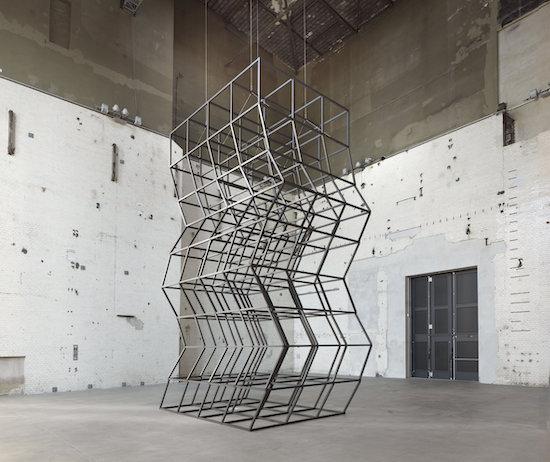When was the last time a work of art made you smile? Leaning against one of the tiled walls in the cavernous Kesselhaus building in Berlin, it is impossible to ignore the sense of collective amusement that surrounds me. It is all caused by London artist Mona Hatoum’s triumphantly wonky new installation piece, all of a quiver.
Her shuddering, kinetic matte black tower of squares is triumphantly erected in the middle of a former brewery turned contemporary art space. At twenty metres tall the metal sculpture dangles from motorised winches positioned way up in the heavens. Set in a skylight, the motor pushes and pulls it – announced by an eerie high-pitched whine – in and out of shape in a timed cycle.
So far, so mechanical. But look closer. When the squares of the sculpture start to flex out of shape, that’s when things start to get weird. The mutating grid causes your eyes to try to correct it. With more flexing and wobbling your brain is forced to surrender with a helpless chuckle. The linear perspectives vanish and twist into something far more psychedelic and disarming. It suggests that our entire existence is precarious – but that reconstruction and renewal is also possible.
Located in Berlin’s southeast borough of Neukölln, the installation from Beirut-born artist Hatoum sits in the tall centrepiece building of the KINDL art complex. The interior scars revealing the building’s transformation from boiler house to gleaming art space are visible in this towering room, with only its ghostly white hygienic walls providing a counterpoint to the slick black skeleton.
“This is a very special space – so of course it required a site-specific installation,” Hatoum says in a video made by KINDL. “I decided to take advantage of the vertiginous height here. It looks like the bare bones of a building that could be in the process of being built – or stripped for demolition. It’s based on an idea I had on my mind for ten or twelve years, which I was never able to realise as it seemed impossible to build.”
When the wonky grid is returned to its full height and rests aloft and strong, it works as a perfectly intriguing bit of sculpture. Its cyclical animation is what pushes it into another league and forces the viewer to be confounded by its strange, if eventually logical and repetitive, movements.
Facing it, you see four rows of nine squares. Turn the corner and you notice it’s three squares deep. When all 108 squares start to move, the visual mischief kicks in as the geometry collapses, warps, shakes, distorts, bulges and bends. And then it stops.
KINDL curator Kathrin Becker tells me this is the first time that the work of Hatoum has been shown at the space. She adds that she had set “no restrictions” for the installation – other than for any technical or logistical issues. “The space is very vulnerable,” Becker explains. “So, it was a real challenge to create a hanging kinetic sculpture here.”
Roughly one year elapsed between the original commission and the installation of the work. And once it was created by Hatoum, installing the sculpture took approximately five weeks. “Meticulous technical issues had to be planned and various questions concerning the space had to be considered,” Becker says with a sense of relief.
“Her work addresses global issues – but these, of course, apply to local audiences in Berlin, as well. The formal reference to a building being constructed and deconstructed will be something familiar to inhabitants of any large city. She found a perfect form for humanity’s shaky existence for the very specific Kesselhaus and its huge dimensions. It’s a comment on our current times and our global upheaval.”
The monumental sculpture is just part of a larger survey of Hatoum’s work that is spread across the city. Two other free exhibitions of her work of the past twenty years are on show at the Neuer Berliner Kunstverein (NBK) located in the central borough of Mitte, as well as the Georg Kolbe Museum near the city’s Olympic stadium.
“This is the largest survey of my work ever shown in Berlin,” says Hatoum. “And they couldn’t be more different from each other.”
Both of these impressive shows feature a large range of works from Hatoum – with many of them offering similar reflections on our global instability and geopolitical threats, with a fascinating use of cartography and mapping to communicate these themes. Instability is inextricably linked to Hatoum’s worldview. She was born in Beirut in 1952 to Palestinian parents. And while on a brief visit to London in 1975, civil war broke out in Lebanon and prevented her from returning home.
At the NBK, her large 2006 work titled Hot Spot features prominently – a giant exoskeleton of a globe with the outline of the continents lit up with red LED lights. “It’s when I decided that conflict and unrest is affecting the whole world,” Hatoum says. “And it still seems relevant today. It acquired another meaning as a symbol of global warming and as a reference to the climate emergency.”
Back at KINDL, the steady stream of onlookers continue to stream into the space for a look at the quivering tower, circling it to inspect if it’s real and to understand what’s possessing it.
“I was very pleased when NBK approached us to ask if we wanted to be part of a larger survey exhibition involving different venues in Berlin,” Becker adds. “Mona Hatoum is one of the most important contemporary artists and I’ve wanted to work with her for a long time. She finally found the space she wanted for her installation.”
all of a quiver is on display at the Kesselhaus at KINDL, Berlin, until 14 May 2023


